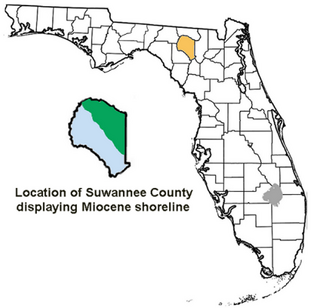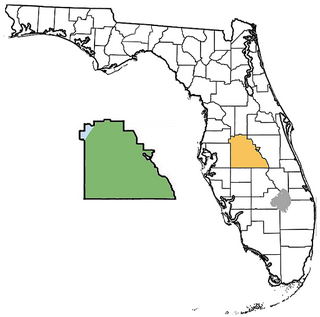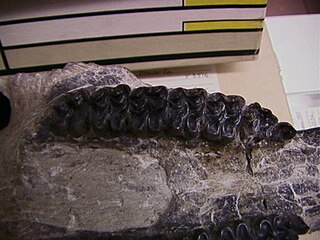

The Gadsden County paleontological sites are assemblages of Early Miocene invertebrates and vertebrates occurring in Gadsden County, Florida, United States.


The Gadsden County paleontological sites are assemblages of Early Miocene invertebrates and vertebrates occurring in Gadsden County, Florida, United States.
Era : Neogene
Period : Early Miocene
Faunal stage : Hemingfordian ~20.6—16.3 Mya, calculates to a period of approximately 4.3 million years
Geologic formation : Torreya Formation
Gadsden County paleontological sites are represented by the following:
La Camelia Site. Time period: 17.7 Mya. (AEO)
Midway Site. Time period: ~18.9—18.8 Mya.
Milwhite Gunn Farm Site. Time period: ~17.0 Mya. (AEO)
Quincy Site. Time period: ~17.0 Mya. (AEO)
Coordinates: 30°30′N84°30′W / 30.5°N 84.5°W
La Camelia site = LCS. Midway site. = MIS. Milwhite Gunn Farfm Site. Marks River site = MGFD. Quincy site = QUI.

Merychippus is an extinct proto-horse of the family Equidae that was endemic to North America during the Miocene, 15.97–5.33 million years ago. It had three toes on each foot and is the first horse known to have grazed.

Castoroides, or the giant beaver, is an extinct genus of enormous, bear-sized beavers that lived in North America during the Pleistocene. Two species are currently recognized, C. dilophidus in the Southeastern United States and C. ohioensis in most of North America. C. leiseyorum was previously described from the Irvingtonian age but is now regarded as an invalid name. All specimens previously described as C. leiseyorum are considered to belong to C. dilophidus.

Hesperocyon is an extinct genus of canids that was endemic to North America, ranging from southern Canada to Colorado. It appeared during the Uintan age, –Bridgerian age (NALMA) of the Mid-Eocene– 42.5 Ma to 31.0 Ma. (AEO). Hesperocyon existed for approximately 11.5 million years.

Syndyoceras is a small extinct genus of Artiodactyla, of the family Protoceratidae, endemic to central North America from the Miocene epoch, existing for approximately 4.2 million years.
Parahippus leonensis is an extinct proto-horse of the family Equidae that was endemic to North America during the Miocene from 23.030 to 16.3 Ma living for approximately 6.73 million years.

Pseudhipparion is an extinct genus of three-toed horse endemic to North America during the Miocene. They were herding animals whose diet consisted of C3 plants. Fossils found in Georgia and Florida indicate that it was a lightweight horse, weighing up to 90 pounds. In 2005, fossils were unearthed in Oklahoma. Seven species of Pseudhipparion are known from the fossil record which were very small, following the trend of Bergmann's rule.

Nannippus is an extinct genus of three-toed horse endemic to North America during the Miocene through Pleistocene, about 13.3—1.8 million years ago (Mya), living around 11.5 million years. This ancient species of three-toed horse grew up to 3.5 feet and weighed between 165 pounds to 199 pounds, which was around the same size as a domestic sheep.

The Orleanian age is a period of geologic time, within the Miocene and used more specifically with European Land Mammal Ages. It precedes the Astaracian age and follows the Agenian age.

The Thomas Farm site is an Early Miocene, Hemingfordian assemblage of vertebrate fossils located in Gilchrist County, northern Florida.

The Torreya Formation is a Miocene geologic formation with an outcrop in North Florida. It is within the Hawthorn Group.

The Haile Quarry or Haile sites are an Early Miocene and Pleistocene assemblage of vertebrate fossils located in the Haile quarries, Alachua County, northern Florida. The assemblage was discovered during phosphate mining, which began in the late 1940s. Haile sites are found in the Alachua Formation. Two sites within the Ocala Limestone yielded Upper Eocene Valvatida and mollusks.

The Leon County paleontological sites are assemblages of Early Miocene invertebrates and vertebrates of Leon County, Florida, United States.

The Jefferson County, Florida paleontological sites are assemblages of Mid-Miocene to Late Pleistocene vertebrates from Jefferson County, Florida, United States.

The Hawthorn Group is a stratigraphic unit of Miocene age in South Carolina, Georgia, and Florida, in the United States. It is known for its phosphate rock resources, and for its rich assemblages of Neogene vertebrate fossils.

The Suwannee County, Florida paleontological sites are assemblages of Early Miocene invertebrates and vertebrates occurring in Suwannee County, Florida.

The Polk County paleontological sites are assemblages of Early Miocene to Late Pleistocene vertebrates occurring in Polk County, Florida, United States.

Scaphohippus is an extinct Miocene genus of equine, with two known species, known from fossils found in California, New Mexico, Montana, and Nebraska.

Paleontology in Florida refers to paleontological research occurring within or conducted by people from the U.S. state of Florida. Florida has a very rich fossil record spanning from the Eocene to recent times. Florida fossils are often very well preserved.
The Alum Bluff Group is a geologic group in the states of Georgia, Florida, and Alabama. It preserves fossils dating back to the Neogene period.
The Parachucla Formation is a geologic formation in the southeastern United States. It preserves fossils from the Aquitanian stage of the early Miocene period. The formation is included in the Hawthorn Group. An exposure at the northern end of the formation has produced fossils estimated to be 19.4 to 20.5 Million years ago (Ma). Another exposure at the southern end of the formation has produced fossils estimated to be 23.9 to 24.7 Ma.